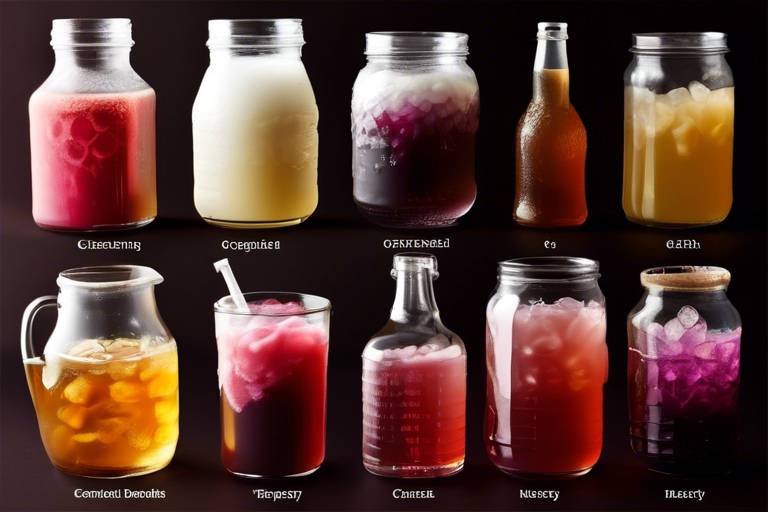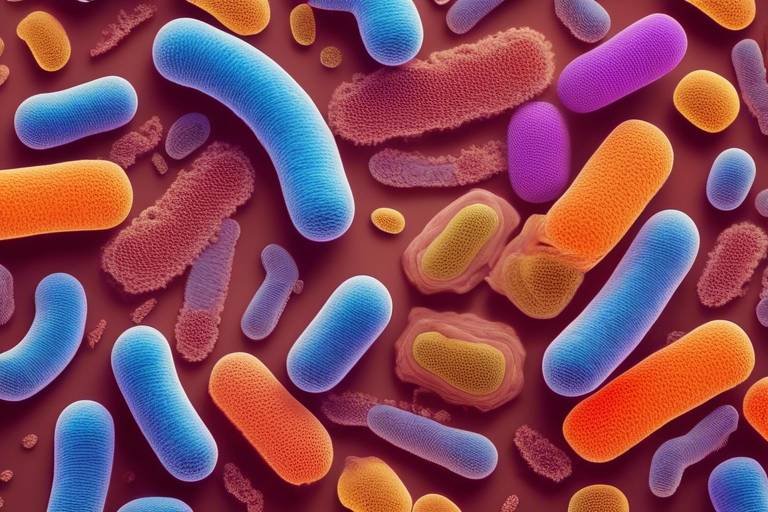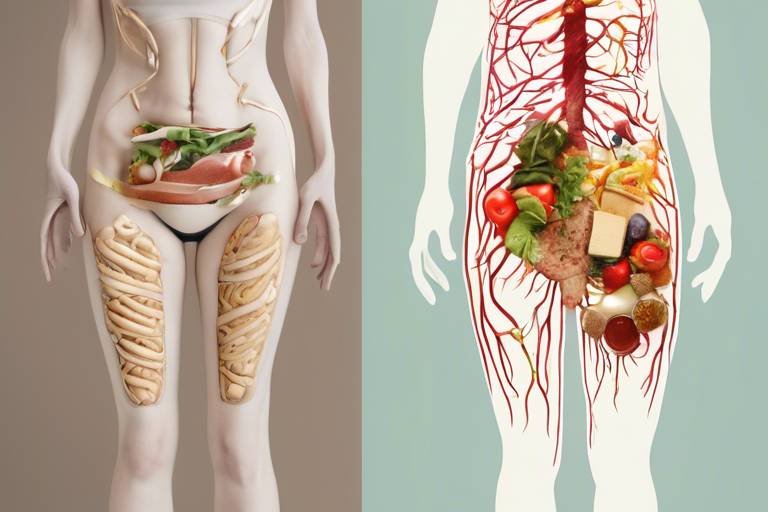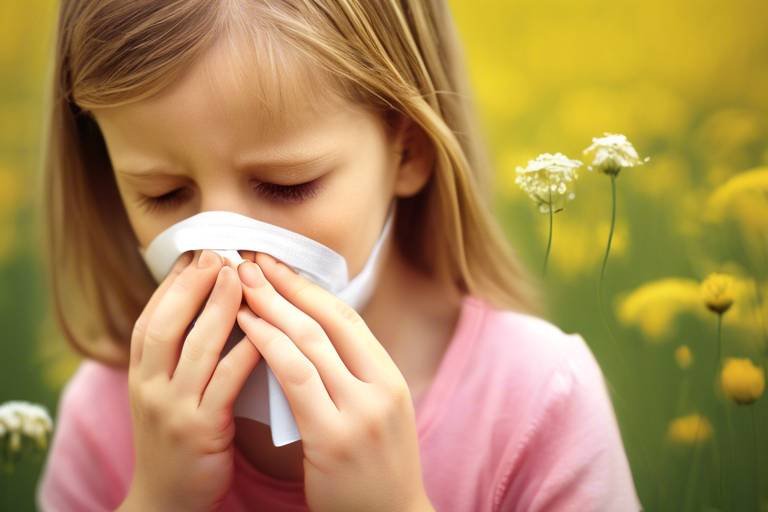The Science of Plant Growth - Tips for Your Garden
Gardening is more than just digging in the dirt; it's an intricate dance of science and nature. When you plant a seed, you're not just hoping for the best; you're working with the fundamental principles of plant growth to create a thriving garden. In this article, we’ll explore the fascinating world of plant growth, diving into the science behind it and offering practical tips to help your garden flourish. So grab your gardening gloves and let’s dig in!
At the heart of plant growth lies a magical process known as photosynthesis. This is how plants convert sunlight into energy, using chlorophyll to transform carbon dioxide and water into glucose and oxygen. Think of it as a plant's way of cooking its meals using sunlight as the main ingredient. By understanding this vital function, you can create conditions that optimize photosynthesis in your garden. For instance, placing plants in areas with ample sunlight can significantly boost their energy production, leading to healthier and more vigorous growth.
Imagine trying to build a house on sand—your structure would collapse! Similarly, the foundation of your garden is the soil. The composition of soil—which includes nutrients, pH levels, and texture—plays a crucial role in plant health. Healthy soil is rich in organic matter and has a balanced pH, typically between 6.0 and 7.5 for most plants. To ensure your plants thrive, consider conducting a soil test to understand its composition. This knowledge allows you to amend the soil appropriately, adding compost or fertilizers as needed to create a nutrient-rich environment.
Watering is like the lifeblood of your garden. However, it’s not just about dousing your plants with water; it's about knowing the right techniques and timing. Overwatering can drown roots, while underwatering can lead to wilting. A good rule of thumb is to water early in the morning or late in the afternoon to minimize evaporation. Consider using a drip irrigation system or soaker hoses for efficient watering, delivering moisture directly to the roots where it's needed most. Remember, each plant has unique watering needs, so pay attention to their signals!
Just like humans need food to grow and stay healthy, plants require nutrients to thrive. This is where fertilizers come into play. They provide essential nutrients such as nitrogen, phosphorus, and potassium, which are crucial for plant growth. There are various types of fertilizers available, including organic and synthetic options. For best results, consider the following:
- Organic Fertilizers: Made from natural sources, they improve soil structure and promote healthy microbial activity.
- Synthetic Fertilizers: Fast-acting and concentrated, these can quickly replenish nutrient levels but may affect soil health over time.
When applying fertilizers, follow the recommended guidelines on the packaging to avoid over-fertilization, which can harm your plants.
Just as we have different preferences for light—some love basking in the sun while others prefer the shade—plants have varying light requirements. Understanding these needs can significantly affect your garden's success. For example, sun-loving plants like tomatoes and peppers thrive in direct sunlight for at least six hours a day, while shade-loving plants like ferns and hostas prefer dappled light. Positioning your plants according to their light needs can optimize their growth and yield.
No gardener wants to see their hard work go to waste due to pests or diseases. Managing these threats is vital for maintaining plant health. Regularly inspect your plants for signs of trouble, such as discoloration or wilting. Implementing preventive measures, like crop rotation and companion planting, can help deter pests naturally. When issues arise, consider using organic pest control methods, such as neem oil or insecticidal soap, to keep your plants safe without harming the environment.
Timing is everything in gardening. Just like you wouldn't wear a winter coat in summer, planting at the right time of year is crucial for maximizing growth and yield. Familiarize yourself with your local climate and the best planting times for various crops. For instance, cool-season crops like lettuce and peas thrive in early spring, while warm-season crops like corn and squash should be planted after the last frost. By aligning your planting schedule with the seasons, you can ensure your plants get the best start possible.
Have you ever heard of companion planting? It’s like hosting a dinner party where all the guests get along! Certain plants can benefit each other when grown together. For example, planting marigolds alongside vegetables can help repel pests, while beans can fix nitrogen in the soil, benefiting neighboring plants. This natural synergy can enhance growth, improve yields, and make your garden a healthier ecosystem.
In today’s digital age, technology can be a gardener's best friend. Numerous tools and apps are available to help monitor plant health, optimize care, and enhance overall gardening efficiency. Consider using soil moisture sensors to ensure you're watering correctly or gardening apps that remind you when to plant and harvest. Embracing technology can take your gardening game to the next level, making it easier and more fun!
Q: How often should I water my plants?
A: It depends on the plant type, soil conditions, and weather. Generally, water when the top inch of soil feels dry.
Q: What is the best time to fertilize?
A: Spring and early summer are ideal times for fertilizing most plants, as they are actively growing.
Q: How can I tell if my plants are getting enough light?
A: If your plants are stretching towards the light or have pale leaves, they may need more sunlight.
Q: What are the signs of overwatering?
A: Signs include yellowing leaves, wilting, and root rot. Always check the soil moisture before watering.

Understanding Photosynthesis
Photosynthesis is like the magical process that transforms sunlight into energy, enabling plants to grow and thrive. Imagine a factory where sunlight, carbon dioxide, and water come together to create food for plants—this is essentially what happens in the leaves of green plants. The key players in this process are chlorophyll, the green pigment found in leaves, and the sun's rays, which kickstart the entire operation. Without photosynthesis, our gardens would be barren, and the food chain would collapse.
During photosynthesis, plants absorb sunlight through their leaves, which contain tiny structures called chloroplasts. These chloroplasts are like solar panels, capturing sunlight and using it to convert carbon dioxide from the air and water from the soil into glucose, a type of sugar that serves as food for the plant. The overall equation for photosynthesis can be simplified as follows:
6 CO2 + 6 H2O + light energy → C6H12O6 + 6 O2
This equation shows that for every six molecules of carbon dioxide and six molecules of water, one molecule of glucose and six molecules of oxygen are produced. The oxygen is released back into the atmosphere, which is fantastic news for us humans and other living beings—after all, we need oxygen to breathe!
Understanding the process of photosynthesis allows gardeners to create optimal growing conditions. For instance, ensuring that plants receive adequate sunlight is crucial. Most plants thrive in full sun, which means they need at least six hours of direct sunlight each day. However, some plants prefer partial shade, so it's essential to know the light requirements of each plant type in your garden.
Moreover, factors such as temperature and humidity also play significant roles in photosynthesis. When temperatures rise too high or drop too low, the efficiency of photosynthesis can decrease, potentially stunting plant growth. Additionally, high humidity can lead to excess moisture, which may promote fungal diseases, while low humidity can stress plants, making them more susceptible to pests.
In summary, grasping the fundamentals of photosynthesis is vital for any gardener looking to cultivate a healthy and productive garden. By ensuring that plants have access to adequate sunlight, water, and the right temperatures, you can significantly enhance their growth and well-being. Remember, a thriving garden is a reflection of the intricate dance between plants and the environment, and understanding this dance can lead to remarkable results!

Soil Composition and Its Importance
Soil composition is like the secret recipe for a thriving garden. Just as a chef needs the right ingredients to whip up a delicious meal, plants require specific components in their soil to grow strong and healthy. The foundation of any garden, soil is not just dirt; it’s a complex ecosystem teeming with life, nutrients, and minerals. Understanding what makes up your soil can dramatically influence the success of your gardening efforts.
At its core, soil is composed of three primary components: minerals, organic matter, and microorganisms. Minerals, which come from weathered rocks, provide essential nutrients like nitrogen, phosphorus, and potassium. Organic matter, derived from decomposed plants and animals, enriches the soil with nutrients and improves its structure. Meanwhile, microorganisms—think of bacteria, fungi, and earthworms—play a crucial role in breaking down organic matter, making nutrients available to plants.
Now, let’s break it down further. Soil can also be categorized based on its texture, which is determined by the size of its particles. Here’s a quick overview of the three main soil types:
| Soil Type | Particle Size | Characteristics |
|---|---|---|
| Sand | Large | Drains quickly, low nutrient retention |
| Silt | Medium | Holds moisture well, rich in nutrients |
| Clay | Small | Retains water, can become compacted |
Understanding these soil types can help you make informed decisions about what plants to grow and how to care for them. For instance, if you have sandy soil, you might want to focus on drought-resistant plants, while clay soil may require amendments to improve drainage. Additionally, the pH level of your soil is another critical factor. Most plants thrive in a pH range of 6.0 to 7.5, which is slightly acidic to neutral. Testing your soil’s pH can guide you in adjusting it with lime or sulfur, depending on whether you need to raise or lower the pH.
Moreover, the importance of soil composition extends beyond just nutrient availability. Healthy soil structure improves aeration and water infiltration, allowing roots to access the moisture and air they need to grow. It’s like giving your plants a cozy home where they can spread their roots wide and deep! So, how can you ensure your soil is in tip-top shape? Regularly adding organic matter, such as compost, is a fantastic way to boost soil health. Not only does it provide nutrients, but it also enhances the soil’s texture and microbial activity.
In summary, understanding soil composition is key to creating a flourishing garden. By knowing the components that make up your soil and how they interact, you can tailor your gardening practices to meet the specific needs of your plants. Remember, a little knowledge about your soil can go a long way in cultivating a vibrant and productive garden!
- What is the best way to test my soil? You can use a soil testing kit available at garden centers or send a sample to a local extension service for analysis.
- How often should I amend my soil? It’s generally good practice to amend your soil once a year, especially in spring or fall, to keep it nutrient-rich.
- Can I improve clay soil? Yes! Adding organic matter like compost can help improve drainage and aeration in clay soil.
- What plants grow best in sandy soil? Drought-tolerant plants such as succulents, lavender, and certain grasses thrive in sandy conditions.

Watering Techniques for Optimal Growth
When it comes to nurturing your garden, watering techniques play a pivotal role in ensuring that your plants not only survive but thrive. Think of water as the lifeblood of your garden; without it, even the healthiest of soils will struggle to support plant life. So, how do you strike the perfect balance? Let’s dive into some effective strategies that can help you master the art of watering.
First and foremost, understanding your plants' specific water needs is crucial. Different plants have varying requirements based on their species, size, and even the season. For instance, succulents and
| Plant Type | Watering Frequency | Best Time to Water |
|---|---|---|
| Succulents | Every 2-3 weeks | Morning |
| Ferns | Weekly | Evening |
| Vegetables | 2-3 times a week | Morning |
| Flowering Plants | Weekly | Morning or Evening |
Another essential aspect of watering is the method you choose. There are several techniques to consider:
- Drip Irrigation: This method delivers water directly to the roots, minimizing evaporation and runoff. It's perfect for conserving water while ensuring deep penetration into the soil.
- Soaker Hoses: Similar to drip irrigation, soaker hoses allow water to seep out slowly along their length, making them ideal for long rows of plants.
- Hand Watering: Sometimes, the old-fashioned way is the best. Using a watering can or hose allows you to control the amount of water each plant receives, which is particularly useful for delicate seedlings.
Timing your watering is just as important as how you water. Early morning is often considered the best time to hydrate your plants, as it allows them to absorb moisture before the heat of the day causes evaporation. Watering in the evening can also be effective, but be cautious—if the foliage remains wet overnight, it can lead to fungal diseases. A good rule of thumb is to ensure your plants receive about 1 inch of water per week, either from rainfall or your watering efforts.
Lastly, it’s vital to monitor the moisture levels in your soil. Overwatering can be just as detrimental as underwatering. You can easily check soil moisture by sticking your finger about an inch into the soil; if it feels dry, it's time to water. Alternatively, consider investing in a soil moisture meter for more precise readings. This simple tool can save you time and help prevent the dreaded root rot that comes from soggy soils.
Q: How can I tell if I'm overwatering my plants?
A: Signs of overwatering include yellowing leaves, wilting, and a musty smell from the soil. If you notice these symptoms, reduce your watering frequency.
Q: Is it better to water deeply once a week or lightly every day?
A: Deep watering encourages strong root growth and is generally more beneficial than light daily watering, which can lead to shallow roots.
Q: Can I use rainwater for my plants?
A: Absolutely! Rainwater is often better for plants than tap water, as it is free from chemicals like chlorine and fluoride. Just make sure to collect it in clean containers.

The Role of Fertilizers
Fertilizers play a crucial role in the world of gardening, acting as the lifeblood that nourishes plants and fuels their growth. Just like we need food to thrive, plants require a variety of nutrients to flourish, and that's where fertilizers come into play. They essentially provide the essential elements that may be lacking in the soil, ensuring that your plants have everything they need to grow strong and healthy.
There are two main types of fertilizers: organic and inorganic. Organic fertilizers, such as compost and manure, are derived from natural sources and improve soil structure over time. They release nutrients slowly, providing a steady supply of nourishment to plants. On the other hand, inorganic fertilizers are synthetically produced and can deliver nutrients quickly, but they may not improve soil health in the long run. Understanding the difference between these types is vital for making informed decisions about how to best feed your plants.
When it comes to applying fertilizers, timing and technique are everything. Over-fertilizing can lead to nutrient burn, which can damage or even kill plants. Therefore, it's essential to follow the recommended application rates and timing specified on the fertilizer packaging. Typically, applying fertilizers in the early spring or during the growing season can yield the best results. For example, a slow-release fertilizer can be applied at the beginning of the growing season to provide a consistent nutrient supply as plants grow.
To better understand the role of different nutrients in fertilizers, here’s a quick breakdown of the primary nutrients and their functions:
| Nutrient | Function |
|---|---|
| Nitrogen (N) | Promotes leafy growth and overall plant vigor. |
| Phosphorus (P) | Encourages root development and flowering. |
| Potassium (K) | Enhances overall plant health, disease resistance, and fruit quality. |
In addition to these primary nutrients, plants also require secondary nutrients and micronutrients, such as calcium, magnesium, and iron, albeit in smaller quantities. It's important to conduct a soil test to determine what nutrients your garden soil might be lacking. This way, you can tailor your fertilizer application to meet the specific needs of your plants.
Moreover, consider the method of application. Fertilizers can be applied through broadcasting, where granular fertilizers are spread evenly over the soil, or through foliar feeding, where liquid fertilizers are sprayed directly onto the leaves. Each method has its advantages, and depending on your specific gardening goals, you may choose one over the other.
Ultimately, using fertilizers wisely can make a significant difference in your garden. They can boost your plants’ growth, enhance flower production, and increase fruit yield. So, the next time you’re out in your garden, think about how you can use fertilizers to unlock the full potential of your plants. Remember, a well-fed plant is a happy plant!
- How often should I fertilize my plants? - Generally, it depends on the type of plants and the fertilizer used. Most plants benefit from fertilization every 4-6 weeks during the growing season.
- Can I use too much fertilizer? - Yes, over-fertilizing can harm your plants. Always follow the recommended application rates.
- Is organic fertilizer better than synthetic? - It depends on your gardening goals. Organic fertilizers improve soil health over time, while synthetic fertilizers provide quick nutrient availability.

Light Requirements for Different Plants
When it comes to gardening, understanding the light requirements for your plants is absolutely essential. Just like humans need sunlight to feel energized and healthy, plants rely on it to grow and thrive. But here's the kicker: not all plants are created equal when it comes to their light needs. Some are sun-worshippers, while others prefer the shade. So, how do you ensure that your green friends get just the right amount of light? Let's break it down.
First off, we have full sun plants. These beauties crave at least six hours of direct sunlight each day. Think of them as the sunbathers of the plant world. Examples include tomatoes, peppers, and sunflowers. If you want to grow these vibrant plants, make sure to place them in a spot that gets ample sunlight throughout the day. A sunny spot in your garden or even a south-facing window can work wonders.
On the flip side, we have partial sun or partial shade plants. These plants are a bit more flexible, thriving in about four to six hours of sunlight daily. They're the easy-going friends who can adapt to different situations. Think of lettuce, spinach, and azaleas. These plants do well in areas that receive morning sun and afternoon shade, helping them avoid the harshest rays of the day.
Now, let's talk about shade-loving plants. These are the introverts of the plant kingdom, preferring less than four hours of direct sunlight. They thrive in dappled sunlight or even full shade. Some great examples include ferns, hostas, and caladiums. If your garden has a lot of trees or structures casting shadows, these plants will be right at home.
To help you visualize these light requirements, here’s a handy table:
| Light Requirement | Examples of Plants |
|---|---|
| Full Sun (6+ hours) | Tomatoes, Peppers, Sunflowers |
| Partial Sun/Partial Shade (4-6 hours) | Lettuce, Spinach, Azaleas |
| Shade (Less than 4 hours) | Ferns, Hostas, Caladiums |
Understanding these categories is crucial, but it’s not just about knowing what plants belong where. You also need to consider the season and geographic location. For instance, a plant that thrives in full sun in one region might struggle in another area with a different climate. Always observe how your plants respond to their environment. If they appear leggy or stretched out, they may be searching for more light. Conversely, if leaves start to scorch, they might be getting too much sun.
In addition to direct sunlight, the angle of light plays a significant role. During different seasons, the sun’s angle changes, affecting how much light your plants receive. It’s a good idea to rotate your pots or reposition your plants as the seasons change to ensure they get the best exposure possible.
In summary, knowing the light requirements of your plants can make all the difference in your gardening success. By placing them in the right spots and being mindful of their needs, you can cultivate a thriving garden that flourishes under the sun. Remember, gardening is as much about observation and adaptation as it is about planting seeds!
- How can I tell if my plant is getting too much light? Look for signs like scorched leaves or leaf drop. If your plant appears leggy, it may need more light.
- Can I grow plants indoors without natural sunlight? Yes! Many plants do well under grow lights, which can mimic the sunlight they need.
- What should I do if my garden has too much shade? Consider planting shade-loving plants or trimming back branches to allow more light in.

Pest and Disease Management
Managing pests and diseases in your garden is like being a detective in a world of green. You have to be vigilant, observant, and ready to act at a moment's notice. Pests can sneak in when you least expect it, and diseases can spread like wildfire if you’re not careful. But don't worry! With a few smart strategies and a bit of knowledge, you can keep your plants healthy and thriving.
First off, let’s talk about prevention. The best defense against pests and diseases is a good offense. Start by choosing resistant plant varieties. Many plants are bred to withstand certain pests and diseases, so do your research before planting. Additionally, maintaining healthy soil is critical. Healthy plants are less susceptible to attacks. This means regularly adding organic matter, such as compost, to enrich your soil with nutrients.
Another key aspect is crop rotation. This technique involves changing the type of plants grown in a specific area each season. By rotating your crops, you can disrupt the life cycles of pests and diseases that thrive on certain plants. For example, if you had tomatoes in a spot last year, consider planting beans or carrots in that same spot this year.
When it comes to identifying pests, a keen eye is essential. Some signs to look out for include:
- Discolored leaves
- Holes in foliage
- Sticky residue on leaves (a sign of aphids)
- Visible insects or webs on plants
Once you spot a problem, you need to act quickly. There are various methods to control pests, including:
- Handpicking: For larger pests like caterpillars, simply picking them off can be effective.
- Insecticidal soap: This is a less toxic option for dealing with soft-bodied insects.
- Neem oil: Derived from the seeds of the neem tree, this oil disrupts the life cycle of pests.
As for diseases, proper watering techniques can make a world of difference. Overhead watering can lead to fungal diseases, so consider using drip irrigation or watering at the base of the plants. Additionally, ensure good air circulation by spacing your plants adequately. This helps to prevent moisture buildup, which is a breeding ground for diseases.
Should a disease strike, it’s important to act fast. Remove infected plants immediately to prevent the spread. You can also use fungicides, but always follow the instructions carefully to avoid harming beneficial insects or your plants.
Lastly, don't underestimate the power of beneficial insects. Ladybugs, lacewings, and predatory wasps can help keep pest populations in check. By creating a welcoming environment for these helpful critters, you're not just fighting pests; you’re building a balanced ecosystem in your garden.
Q: How can I tell if my plant is suffering from a pest or a disease?
A: Look for signs like yellowing leaves, wilting, or unusual spots. Pests often leave physical evidence like holes or webs, while diseases may cause discoloration or mold.
Q: Are there any natural remedies for pest control?
A: Yes! You can use mixtures of water with dish soap, neem oil, or even garlic spray to deter pests without harmful chemicals.
Q: How do I attract beneficial insects to my garden?
A: Plant a variety of flowers, such as marigolds or daisies, and avoid using pesticides that can harm these helpful insects.
In conclusion, managing pests and diseases is a vital part of gardening that requires attention and proactive strategies. By understanding your plants and the challenges they face, you can create a flourishing garden that stands strong against the threats of pests and diseases.

Seasonal Planting Strategies
Timing is everything in gardening, and understanding can be the difference between a bountiful harvest and a disappointing yield. Just like a well-timed dance, knowing when to plant, what to plant, and how to care for your plants throughout the seasons can lead to a vibrant garden that flourishes year-round. Imagine your garden as a stage, where each plant plays its role at just the right moment, creating a beautiful symphony of colors, textures, and scents.
When planning your garden, it's crucial to consider the climate in your area. Different regions have unique growing seasons influenced by temperature, rainfall, and frost dates. For instance, in warmer climates, you can start planting earlier in the spring, while in cooler areas, you might need to wait until the threat of frost has passed. To help you better understand the growing seasons, here's a simple table that outlines typical planting times for various vegetables:
| Vegetable | Spring Planting | Fall Planting |
|---|---|---|
| Tomatoes | After last frost (April-May) | Not recommended |
| Lettuce | Early spring (March-April) | Late summer (August-September) |
| Carrots | Early spring (April) | Late summer (July-August) |
| Broccoli | Early spring (March-April) | Late summer (July) |
Another key aspect of seasonal planting is understanding the concept of succession planting. This technique involves planting crops in intervals to ensure a continuous harvest throughout the growing season. For example, you might plant a row of radishes every two weeks. This way, while the first batch is being harvested, new seedlings are already on their way to maturity. It’s like a relay race where each plant passes the baton to the next, ensuring that your garden keeps producing.
Additionally, consider the companion planting method, which pairs plants that benefit each other when grown together. For instance, planting marigolds alongside vegetables can help deter pests, while beans can enrich the soil with nitrogen, benefiting neighboring plants. This strategy not only maximizes space but also enhances the overall health of your garden. It's like having a supportive team where everyone contributes to the success of the group.
As seasons change, so do the needs of your plants. In the spring, focus on nurturing young seedlings with plenty of water and nutrients. As summer approaches, pay attention to watering schedules and consider mulching to retain moisture. When fall arrives, it's time to prepare your garden for winter. This might involve planting cover crops, which help prevent soil erosion and improve soil health for the next growing season. Just like preparing for a long winter's nap, your garden needs some TLC to rest and rejuvenate.
- What are the best vegetables to plant in the spring? - Some great options include tomatoes, peppers, and lettuce, which thrive in warmer temperatures.
- Can I plant vegetables in the fall? - Yes! Many vegetables like kale, carrots, and broccoli can be planted in late summer for a fall harvest.
- How do I know when to plant? - Check your local frost dates and consider your region's climate to determine the best planting times.
- What is succession planting? - It's a method of planting crops in intervals to ensure a continuous harvest throughout the growing season.

Companion Planting Benefits
Companion planting is like throwing a garden party where everyone gets along and helps each other thrive. Imagine your plants as guests at a party; some are great at mingling, while others might just stand in the corner. By strategically placing certain plants together, you can create a harmonious environment that enhances growth, deters pests, and improves overall garden health. This practice isn't just a trend; it's rooted in centuries of agricultural wisdom.
One of the most exciting benefits of companion planting is its ability to naturally repel pests. For instance, planting marigolds among your vegetables can keep nematodes and aphids at bay. It's like having a bodyguard for your plants! Additionally, some plants can attract beneficial insects that prey on harmful pests. For example, planting dill can attract ladybugs, which are known for munching on aphids. So, by choosing the right companions, you can create a natural defense system without resorting to chemical pesticides.
Moreover, companion planting can enhance nutrient uptake in your garden. Certain plants, like corn, can provide support for climbing plants such as beans. The beans, in turn, fix nitrogen in the soil, enriching it for the corn. This symbiotic relationship is a perfect example of how nature works together to create a thriving ecosystem. It’s like a well-coordinated dance, where each participant plays a crucial role in the success of the performance.
Another advantage is the efficient use of space. In a world where garden space can be limited, companion planting allows you to maximize your yields. For instance, planting low-growing crops like lettuce or radishes among taller plants like tomatoes can utilize vertical space effectively. This not only increases your harvest but also helps in reducing weed growth, as the ground is covered more completely by the plants.
To illustrate the benefits of companion planting, let's take a look at a simple table showcasing some popular companion plant pairs:
| Plant Pair | Benefits |
|---|---|
| Tomatoes & Basil | Enhances flavor and repels pests. |
| Carrots & Onions | Onions deter carrot flies, while carrots improve onion growth. |
| Cucumbers & Nasturtiums | Nasturtiums attract aphids away from cucumbers. |
| Corn & Beans | Beans fix nitrogen, benefiting corn growth. |
In conclusion, companion planting is a fantastic strategy for any gardener looking to enhance their green space. By understanding the relationships between different plants, you can create a more productive and healthier garden. So, the next time you plant, think about who your plants would like to hang out with. After all, a happy garden is a productive garden!
- What is companion planting? Companion planting involves growing different plants together to enhance growth, deter pests, and improve overall garden health.
- Can any plants be companions? Not all plants work well together. It's important to research which plants benefit each other and which may hinder growth.
- How do I start companion planting? Begin by selecting a few plant pairs that are known to thrive together and experiment in your garden.
- Is companion planting effective for pest control? Yes, many companion plants can naturally repel pests or attract beneficial insects that help control pest populations.

Using Technology in Gardening
In today's fast-paced world, technology is revolutionizing every aspect of our lives, including gardening. Imagine having a personal assistant that can help you grow your garden more efficiently and effectively. Well, that dream is now a reality! With the advent of smart gardening tools and apps, you can monitor your plants' health, optimize care routines, and even predict the best times for planting and harvesting.
One of the most exciting developments in gardening technology is the use of smart sensors. These nifty devices can be placed in your garden soil to measure moisture levels, temperature, and even nutrient content. By using this data, you can make informed decisions about when to water or fertilize your plants. For instance, if the sensor indicates that the soil is still moist, you can hold off on watering, preventing overwatering, which can be detrimental to plant health.
Furthermore, there are numerous apps available that can help you track your garden's progress. These apps allow you to log your planting dates, monitor growth, and even set reminders for watering and fertilizing. Some popular gardening apps include:
- Gardenize: A comprehensive app for planning and documenting your garden.
- PlantNet: An app that helps you identify plants and learn about their care requirements.
- GrowIt: A community-driven app where you can share your gardening experiences and get advice from fellow gardeners.
Additionally, there are automated watering systems that can be programmed to water your plants at specific times or when the soil moisture drops below a certain level. This technology not only saves you time but also ensures your plants receive consistent care, which is crucial for their growth.
Moreover, drones are making their way into the gardening world, primarily for larger gardens or farms. These flying devices can survey your plants from above, helping you spot issues like pest infestations or nutrient deficiencies before they become major problems. It's like having a bird's-eye view of your garden, allowing you to address issues promptly and efficiently.
For those who love to experiment, hydroponics and aeroponics systems are gaining popularity. These soil-less growing methods use technology to create optimal growing conditions for plants. By controlling factors such as nutrient delivery and light exposure, you can grow plants faster and with less water than traditional gardening methods. It's a game-changer for urban gardeners who may have limited space or poor soil quality.
In conclusion, embracing technology in gardening not only enhances your gardening experience but also leads to healthier plants and more productive yields. Whether you're a seasoned gardener or just starting out, integrating these tools and techniques can make a world of difference. After all, who wouldn't want a thriving garden with less effort?
1. How do smart sensors work in gardening?
Smart sensors measure soil moisture, temperature, and nutrient levels, providing real-time data to help you make informed decisions about watering and fertilizing.
2. Are gardening apps worth it?
Absolutely! Gardening apps can help you track your plants' growth, set reminders for care tasks, and connect with other gardeners for advice and support.
3. Can I automate my watering system?
Yes! Automated watering systems can be programmed to water your plants at specific times or based on soil moisture levels, making plant care easier and more efficient.
4. What are the benefits of hydroponics?
Hydroponics allows you to grow plants without soil, using nutrient-rich water instead. This method can lead to faster growth rates and requires less water than traditional gardening.
5. How can drones help in gardening?
Drones can provide aerial views of your garden, helping you identify issues such as pests or diseases before they escalate, allowing for timely intervention.
Frequently Asked Questions
- What is photosynthesis and why is it important for my plants?
Photosynthesis is the magical process where plants turn sunlight into energy. Think of it as their way of cooking up food! It’s crucial because it allows plants to grow, thrive, and produce oxygen, which is essential for our environment. By understanding this process, you can create the best conditions for your plants to flourish.
- How can I improve my soil composition for better plant growth?
Improving soil composition is like giving your plants a five-star meal! Start by testing your soil for pH and nutrient levels. You can enhance it by adding organic matter like compost, which enriches the soil and improves its texture. Remember, healthy soil is the key to robust plant development!
- What are the best watering techniques for my garden?
Watering is an art! The best technique is to water deeply but less frequently, allowing roots to grow strong and deep. Early morning is the ideal time to water, as it reduces evaporation and helps plants absorb moisture effectively. Just like us, plants prefer a refreshing drink in the morning!
- How do I choose the right fertilizer for my plants?
Choosing the right fertilizer is like picking the perfect outfit for an occasion. You need to consider the specific needs of your plants. Look for fertilizers that provide essential nutrients like nitrogen, phosphorus, and potassium. Always follow the instructions on the package to avoid over-fertilizing, which can harm your plants.
- What light conditions do different plants require?
Just like us, plants have their preferences! Some love basking in full sun, while others thrive in the shade. It’s essential to know the light requirements of your plants to position them correctly. This way, they can soak up the sunlight they need to grow strong and healthy!
- How can I manage pests and diseases in my garden?
Pest and disease management is like being a superhero for your garden! Regularly inspect your plants for any signs of trouble. Use natural remedies like neem oil or introduce beneficial insects like ladybugs to keep pests at bay. Prevention is key, so keep your garden clean and healthy to minimize threats.
- What are some seasonal planting strategies I should know?
Timing is everything in gardening! Plan your planting schedule according to the seasons. For instance, spring is perfect for sowing seeds, while fall is ideal for planting perennials. By understanding the seasonal rhythms, you can maximize growth and yield throughout the year.
- What is companion planting and how does it benefit my garden?
Companion planting is like setting up a friendship network in your garden! Some plants work better together, enhancing each other’s growth and keeping pests away. For example, planting marigolds with tomatoes can deter harmful insects. It’s a win-win for your garden!
- How can technology help me in my gardening efforts?
Technology is a gardener’s best friend! From apps that remind you when to water to sensors that monitor soil moisture, modern tools can make gardening easier and more efficient. Embrace technology to keep your plants healthy and thriving with minimal effort!



















